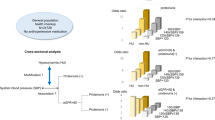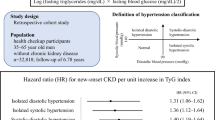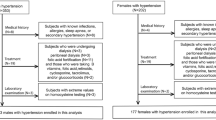Abstract
Microalbuminuria has been proposed as a potential atherosclerotic risk factor in hypertensive individuals. The aim of this cross-sectional population study was to analyse whether microalbuminuria is related to a higher prevalence of cardiovascular disease, and a more atherogenic risk profile, and reversely related to the use of antihypertensive drugs. In a major health screening at the State University Hospital in Copenhagen, including urinary albumin excretion, glomerular filtration rate, blood pressure (BP), electrocardiogram, body mass index, plasma lipoproteins, fibrinogen, and albumin, and information regarding a history of acute myocardial infarction, smoking, and antihypertensive drugs, 1254 participants without diabetes mellitus or renal/urinary tract disease had arterial hypertension. Age range was 30–70 years. Microalbuminuria (nocturnal urinary albumin excretion >15 μ g/min) occurred in 5%, and cardiovascular disease (previous acute myocardial infarction or electrocardiographic Q-waves) also in 5% of the study population. Microalbuminuric hypertensive subjects were characterized by higher age and systolic BP, and a male predominance, as compared to normoalbuminuric hypertensive subjects. The frequency of cardiovascular disease was similar in the two groups. In contrast, when analysed as a continuous variable, a one unit increase in the logarithmically transformed urinary albumin excretion significantly increased the likelihood of cardiovascular disease (odds ratio [95% confidence interval] 1.32 (1.02–1.70); P < 0.05), and this relation was independent of age, sex, and conventional atherosclerotic risk factors. participants who were effectively treated with antihypertensive drugs did not have a lower urinary albumin excretion than insufficiently treated or untreated participants. it is concluded that slightly elevated albumin excretion in the urine is not only a pressure-dependent functional phenomenon in the glomerular vessel walls, but associated with permanent atherosclerotic abnormalities in the entire vascular system.
This is a preview of subscription content, access via your institution
Access options
Subscribe to this journal
Receive 12 digital issues and online access to articles
$119.00 per year
only $9.92 per issue
Buy this article
- Purchase on Springer Link
- Instant access to full article PDF
Prices may be subject to local taxes which are calculated during checkout
Similar content being viewed by others
Author information
Authors and Affiliations
Rights and permissions
About this article
Cite this article
Jensen, J., Feldt-Rasmussen, B., Borch-Johnsen, K. et al. Microalbuminuria and its relation to cardiovascular disease and risk factors. A population-based study of 1254 hypertensive individuals. J Hum Hypertens 11, 727–732 (1997). https://doi.org/10.1038/sj.jhh.1000459
Received:
Accepted:
Issue Date:
DOI: https://doi.org/10.1038/sj.jhh.1000459
Keywords
This article is cited by
-
A multicenter cohort study of primary hypertension in Korea: study design and interim analysis of the Korean registry of target organ damage in hypertension (KorHR)
Clinical Hypertension (2017)
-
Left Ventricular Mass Index as a Predictor of New-Onset Microalbuminuria in Hypertensive Subjects: A Prospective Study
American Journal of Hypertension (2012)
-
Gestational Diabetes: Implications for Cardiovascular Health
Current Diabetes Reports (2012)
-
Microalbuminuria: do we need a new threshold?
Journal of Human Hypertension (2009)
-
Efficacy and safety of initial combination therapy with amlodipine/valsartan compared with amlodipine monotherapy in black patients with stage 2 hypertension: the EX-STAND study
Journal of Human Hypertension (2009)



